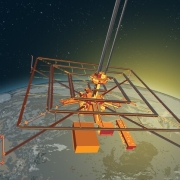The idea of beaming clean energy down to Earth from orbiting arrays of solar panels seemed pretty wacky when it first crossed the CleanTechnica radar. However, the technology building blocks are already at hand. It’s just a matter of scaling, systems integration, and adjustments for space-hardiness. That sounds simple enough, but many hands have been trying to make space solar happen for many years, and now the US Space Force may be helicoptering in to lend a hand.
The Space Solar Race Is For Real
Research teams from the US, China, and the UK are among those chasing the space solar rainbow. The attraction of space solar is the potential for 24/7 solar power at the multi-gigawatt scale, all year long. That has implications for military use as well as civilian life.
The US Department of Defense has already begun using solar arrays and energy storage to build more resilience and security into its facilities and operations. Access to solar energy from space would kick that effort into high gear.
Click here to read the full article
Source: Clean Technica
—
If you have any questions or thoughts about the topic, feel free to contact us here or leave a comment below.


